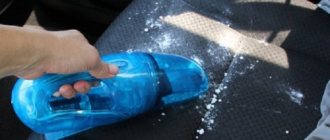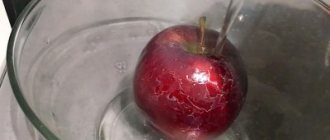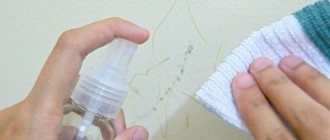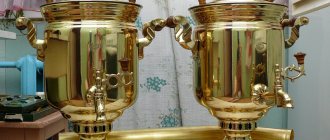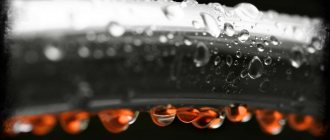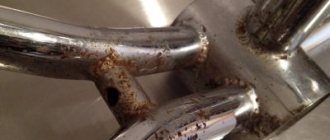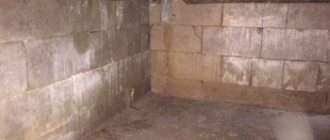The risk of mold and mildew is high in rooms where there is often dampness and the air is warm. Under suitable conditions, colonies of microscopic fungi multiply rapidly.
Most often, harmful fungi appear in the bathroom and toilet. You can’t just wash it off, so you should pay attention to several effective ways to eliminate mold from the ceiling.
Why does she appear
Several reasons or a combination of them lead to the appearance of mold and mildew:
- ventilation system malfunction;
- leaks from overlying ceilings, roofs or through cracks in walls;
- non-compliance of external enclosing structures with the standardized resistance to heat transfer.
Mold on the ceiling and wall
ATTENTION! Mold and mildew are always a consequence, and before starting to treat the ceiling, it is necessary to identify the root cause of the problem and eliminate it.
In apartment buildings - find out from the upper residents why leaks are occurring; if the reason is in the roof or cracks in the walls - oblige the HOA or utility services to bring all structures into working condition. In individual housing, it may be necessary to insulate the walls and roof, since if there is insufficient thermal insulation, condensation will always appear on the inner surface of the ceiling or in the corners of the outer walls, which over time leads to contamination of the surfaces with fungal spores.
Causes of mold growing indoors
Molds are already a consequence of a problem that must be found and eliminated first. Humidity can be the result of construction errors and accidents.
Variants of technical deficiencies that contributed to the formation of mold:
- Ineffective or absent ventilation
- Leaking sewer or water pipes
- Flooding
- Condensation resulting from insufficient insulation
- Violation of roof waterproofing
Important! Without eliminating these problems, mold can only be eliminated for a while.
Folk remedies
Long before the advent of modern drugs, our ancestors learned to fight mold and mildew on a variety of surfaces with means that are present in every home and which are always on sale in a store or pharmacy.
Mold on the ceiling
Let's look at how to get rid of mold on the ceiling in a room or bathroom using:
- vinegar;
- hydrogen peroxide;
- soda;
- Australian tea tree essential oil;
- copper sulfate;
- laundry soap.
Vinegar
You can get rid of mold by treating the affected areas with table vinegar or diluted vinegar essence. It is enough to moisten a rag with a 6-9% solution and thoroughly wipe the stains and adjacent surface. Vinegar has an unpleasant odor and causes burns in high concentrations, so you should take precautions when working: wear gloves, protect your eyes and clothing. You can use a spray bottle and spray the ceiling in the bathroom, then wipe with a damp cloth, repeat the procedure 2-3 times every week.
Peroxide
Hydrogen peroxide is a pharmaceutical antiseptic; on the ceiling it will not only destroy fungi and spores, but also whiten the surfaces. The advantages of using this substance are odorless, hypoallergenic and harmless. The previously affected areas are cleaned of the paint layer with a spatula or a metal brush, then the solution is applied with a damp cloth or spray bottle for 10-15 minutes, and cleaned again for a long-term effect.
Soda
Every housewife has baking soda - it is used in cooking and for cleaning, and it can also destroy mold on the ceiling.
Using soda to combat fungal colonies: after cleaning surfaces from contaminated paint and plaster, moisten the ceiling with a solution in the proportion of 1 teaspoon per glass of water. To enhance the effect, you can add tsp. vinegar. If there are significant mold colonies, repeat the procedure.
Tea tree essential oil
Tea tree essential oil also has antiseptic and antimicrobial properties and is great for treating moldy areas. For 0.5 liters of water, it is enough to use 50 ml of essential oil, pour the solution into a spray bottle and treat the ceiling with it, wipe with a rag. After drying, repeat the treatment.
Attention! The specific aroma of the oil will disappear within 2 days.
Copper sulfate
Copper sulfate is a bright blue metal salt, widely used in construction and for treating fruit plants. To remove mold on the ceiling in an apartment, prepare a solution of 10 liters of warm water and 100 g of vitriol. You can enhance the effect of the product by adding 1-2 tablespoons of vinegar, a few drops of tea tree oil, or chlorine bleach.
Before treatment, the contaminated paint layer and plaster are removed mechanically. The solution is applied with a rag, brush or spray bottle. In case of severe contamination of the surface, the treatment is repeated 3-5 times.
ATTENTION! When using the solution, caution is required - protect your eyes; if it gets on the skin, wash with soap.
Laundry soap
Perhaps the simplest method of fighting fungus is to use a soap solution: rub a piece of laundry soap and dissolve it in 10 liters of water, you can enhance the effect by adding 5 tbsp. spoons of soda ash. After mechanical cleaning, the stains are washed with the prepared composition, dried, and the procedure is repeated if necessary.
Mold Removal
Mold is a fast-growing fungus, and you will have to remove not only its surface, visible layer with spores, but also the entire mycelium that has penetrated deep into the building materials.
Increased mold
It is recommended to completely dismantle plaster and plasterboards affected by mold along with the mycelium that has grown in them.
Important! Mold spores with mycotoxins pose a major health threat. When removing mold, you need to wear a respirator, safety glasses and rubber gloves. There should be no exposed skin to avoid allergic or skin diseases.
If the mold outbreak is detected in a timely manner and consists of small spots, the fungus can be removed by simply treating it with an antiseptic as the main means of combating mold.
The cleared ceiling of the building layer with elements of mycelium ingrown into them is also treated with an antiseptic.
An antifungal antiseptic completely destroys mold, its spores and mycelium. Thanks to its penetrating ability, possible remnants of mycelium are eliminated at a depth of 3–5 mm, depending on the porosity of the material to which the mold control and protection agent is applied.
Chemical substances
Modern construction chemicals will help remove mold from the ceiling in an apartment reliably and quickly. There are many different antiseptics on sale for various surfaces - wood, brick, concrete, natural stone. The consultant will tell you how to process a specific material. We will look at how to remove mold from the ceiling in an apartment using the most effective drugs.
Xiolate
The product is water-based, has a pungent odor, and can be used in well-ventilated areas. Xiolate penetrates the molecular structure of materials of various origins, dissolves mold and crystallizes into a surface film, blocking access to oxygen, thereby preventing fungi from subsequently multiplying.
The undeniable advantages of the product are efficiency, prevention of re-infection by microorganisms, the disadvantage is the high price.
Teflex
A Russian development with a powerful antiseptic and fungicidal effect is used on external and internal surfaces. The product is added to concrete, paints and adhesives, preventing infection by fungi. To destroy mold colonies, an aqueous solution of Teflex is applied to any surface. The drug is effective, economical, but has an unpleasant odor.
Biolavatio
A broad-spectrum product produced by Sadolin, approved for use in hospitals and children's institutions, has an additional whitening effect.
Nature antimantar
Water-based primer with antibacterial properties for use with a brush or roller. Effective, but has a high price. Requires thorough preliminary cleaning of surfaces from dust and dirt.
Further prevention
There are quite a few ways that make it possible to get rid of mold. But preventing its occurrence is much easier. To do this, it will be enough to follow simple recommendations that will make it possible to never find out what mold is:
- ventilate the room regularly;
- try not to let the room temperature drop too much;
- do not hang wet laundry around the apartment to dry;
- promptly repair all connections through which water passes;
- Monitor the condition of ventilation materials, especially in the bathroom. If draft is weak, consider additional forced ventilation;
- When renovating an apartment, use only moisture-resistant materials.
Do not forget about one detail: fungus and mold appear when the temperature is about 20 degrees and humidity is 90%. Therefore, it is important to ensure that the humidity in the apartment is not high for a long period.
It is much easier to prevent mold than to eliminate its consequences later. By following simple recommendations, you will protect yourself from negative consequences.
Also watch a useful video on how to remove mold from the ceiling in an apartment using folk remedies:
How to remove fungus under a suspended ceiling with your own hands?
The reason for the appearance of mold and fungal colonies in the space behind the suspended ceiling is the lack of ventilation with high humidity in the room.
To destroy harmful microorganisms it is necessary:
- dismantle the tension fabric;
- treat the ceiling in any effective way to clean the surface;
- apply an antifungal agent;
- dry;
- Mount the ceiling in its original position.
Drying the surface
After applying the antiseptic to the mold-affected base, it is necessary to ensure that it dries completely. For this, conventional ventilation is most often used. Next, you need to dry the entire ceiling very well, for which additional units such as a heat gun or household heater are used. Only complete removal of residual moisture will guarantee that the fungus will not appear again.
A completely dry and cleaned base will require decorative finishing. It is best to use one of the hanging systems, which will simply block the surface prone to “blooming” from visual viewing. In this regard, tension systems and lining (preferably plastic) have proven themselves very well. The latter option is well suited for wet rooms, because... the base base will be well ventilated.



